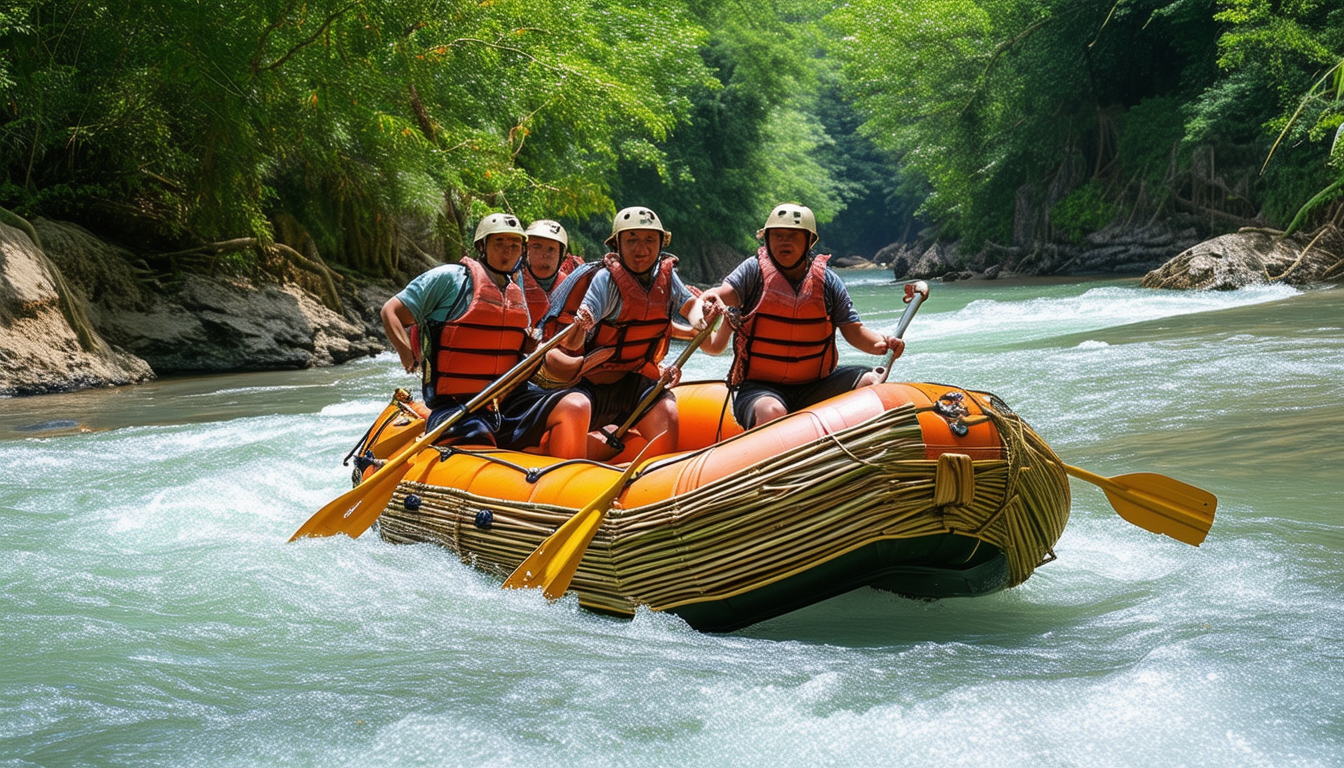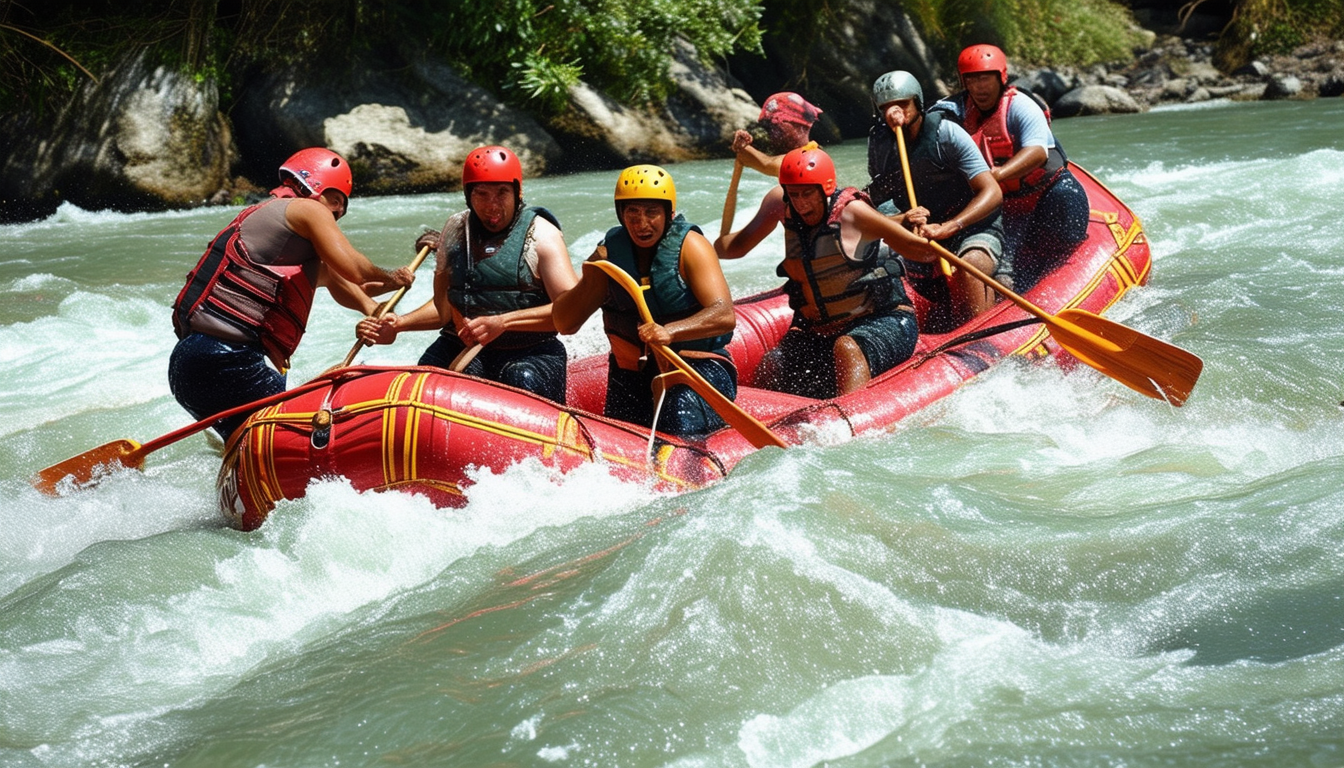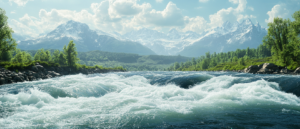Key Takeaways
- The beginnings of floating on rivers can be traced back to early civilizations.
- Trailblazers in turbulent water navigation significantly influenced the sport’s development.
- The evolution of rafting transformed it into an established recreational activity.
- The influence of this water sport extends into various cultures and communities.
Who Started Rafting | The Origins of Rafting
The origins of rafting trace back to the early use of simple rafts made from natural materials, where early rafters would navigate rivers for transportation and fishing. Historical evidence suggests that humans have been utilizing rafts for thousands of years, with boaters on ancient rivers engaging in what resembles modern river rafting. As civilizations evolved, so did raft building techniques, leading to the development of more robust whitewater rafts capable of withstanding turbulent waters. The transition from basic rafts to specialized whitewater rafting equipment reflects the growing interest in adventure sports. Today, rafters and kayakers alike explore rafting rivers, embracing both the thrill of whitewater rafting and the serenity of kayaking on calmer waters. The question of who started rafting encompasses diverse cultures that have shaped the sport into what it is today.
who started rafting | Historical Context of Rafts
The origins of rafting can be traced back to ancient civilizations that utilized various forms of watercraft for transportation and fishing. Early boats, made from materials like wood and reeds, allowed paddlers to navigate through calm waters and challenging rapids. As technology evolved, the introduction of inflatable boats and folding kayaks transformed the landscape of boating. These innovations made it easier for adventurers to tackle whitewater rapids and engage in activities like canoeing and kayaking.

Who started rafting is often linked to the broader history of waterway exploration. Pioneers of the sport embraced new techniques, enhancing their paddling skills to conquer turbulent waters. Kayakers and canoeists began to push the limits of their boats, seeking thrills and challenges in natural river systems. The evolution from simple rafts to sophisticated watercraft marked a significant shift in recreational activities, attracting enthusiasts who desired the exhilaration of paddling through dynamic river landscapes.
| Era | Key Developments | Significance |
|---|---|---|
| Ancient Civilizations | Use of wooden and reed boats | Foundation of watercraft for transport and fishing |
| 19th Century | Introduction of inflatable boats | Increased safety and accessibility for recreational use |
| 20th Century | Development of specialized rafts and kayaks | Launched whitewater rafting as an adventure sport |
| Present Day | Advancements in materials and technology | Enhanced performance and safety in rafting gear |
Early Uses of Rafting
Rafting has its roots in ancient methods of navigating waterways, where early civilizations utilized simple structures crafted from timber and animal hides. These rafts often took the form of canoes or keelboats, allowing people to traverse rivers and transport goods. Historical accounts suggest that those who started rafting used these early crafts for fishing and trade, relying on paddles to maneuver through calm waters. As watercraft design evolved, so did the materials. Rubber boats began to emerge as a popular choice, particularly for their buoyancy and durability on both gentle waterways and more challenging whitewater rivers.
The development of rafting techniques also paralleled advancements in shipbuilding. As rivers served as vital arteries for transportation, innovations arose to improve speed and safety. Lifeboats and barges became more sophisticated, while paddling techniques were refined into competitive practices like kayak slalom and canoe slalom. The riverbed’s characteristics influenced how these boats interacted with different water conditions, solidifying the importance of understanding waterways in early rafting practices. Knowledge passed down through generations laid the groundwork for the recreational and competitive rafting we see today.
Pioneers of Whitewater Rafting
The history of rafting is rich with influential figures who shaped the sport as we know it today. Who started rafting can be traced back to the early days when rowers navigated their original rafts on popular waterways like the Clearwater River. During these early rafting days, enthusiasts embarked on their first rafting trips, which laid the groundwork for what would eventually emerge as the commercial rafting industry. The establishment of the first rafting company marked a significant milestone in recreational rafting, allowing more people to experience the thrill of whitewater navigation. As the concept of do-it-yourself rafting gained traction, early rafters began experimenting with eastern-developed rafts and improved rafting equipment, which contributed to the evolution of rafting expeditions. These developments not only defined the sport but also inspired future generations to explore the waterways.
Key Figures in Rafting History
Rafting has evolved through the contributions of several key figures who laid the groundwork for modern practices. The pioneers of this adventure sport included those who started rafting using simple wooden rafts, showcasing impressive raft building skills. As the popularity of whitewater rafting booms, commercial rafting operators emerge, providing organized rafting trips. These first rubber rafts allowed for the development of multi-person rafts, enhancing the experience for rafting participants. Colorado rafting became a popular rafting destination, attracting adventurers eager to test their skills against Nature’s currents.
The passion of old rafters and do-it-yourself rafters helped shape the rafting community and establish professional techniques that define modern-day whitewater rafting. They shared invaluable insights, ensuring safety and enjoyment during trips. Notable figures, including professional rafting guides, have made significant contributions by leading commercial rafting trips and promoting best practices. This blend of history and innovation continues to inspire new generations of rafting enthusiasts, maintaining the thrill of navigating the waters.
- The invention of the inflatable raft revolutionized the sport, making it accessible to more people.
- Pioneering guides, like Charlie Smith, played a crucial role in developing effective safety protocols.
- Organizations like the American Canoe Association helped standardize training and certification for rafting guides.
- Early female rafters broke gender barriers, paving the way for inclusive participation in the sport.
- Environmental advocates within the rafting community have worked to promote conservation efforts on rivers.
- The introduction of river rafting competitions has further popularized the sport, showcasing skills and teamwork.
- Influential films and documentaries have raised awareness and sparked interest in rafting adventures.
The Evolution of Rafting Techniques
Rafting originated with primitive rafts used by early humans for transportation and fishing. Historical accounts reveal that who started rafting tapped into various materials, such as wood and reeds, to create sturdy wooden rafts. Over time, the evolution of these early vessels led to the development of war rafts, designed for military purposes, showcasing the adaptability of raft designs. As rafting gained popularity, the emergence of commercial rafting companies transformed the activity, offering commercial rafting trips on rivers using modern whitewater rafts that were specifically engineered for safety and performance.
The transition from primitive rafts to more advanced designs introduced innovations like inflatable rafts and rubber rafts that are commonly used today. The combination of modern whitewater raft materials has allowed for increased durability and maneuverability in challenging conditions. The rise of raft/rodeo events, a one-of-a-kind rafting event, reflects the sport’s growing complexity and excitement. Commercial rafting operators have embraced these advancements, facilitating thrilling experiences for adventurers seeking adrenaline-fueled excursions. This evolution has not only shaped the techniques used but has also expanded the scope of rafting as a recreational activity.
Rafting Matures as a Sport
The evolution of rafting as a sport began with early pioneers who embraced the thrill of navigating rivers. Who started rafting can be traced back to various cultures utilizing crafted rafts for exploration and transportation. John Fremont designed the first rubber raft, paving the way for modern innovations such as inflatable rafts and self-bailing rafts. Rubber river rafts gained popularity, especially with companies offering guided rafting trips that appeal to both novices and experienced raft racers. Avon rafts emerged as a prominent choice among enthusiasts, leading to organized events like the 26-mile rafting race. The establishment of the International Rafting Federation helped standardize competitions and promote the sport globally. Resources like www.whitewaterrafting.com/rafting-info/history provide insight into these developments, showcasing how military rafts and scientific rafting exploration contributed to the maturation of rafting into an organized and celebrated activity, including full-day rafting trips that cater to adventurers seeking excitement on the water.
Development of Rafting Equipment
The evolution of rafting equipment has seen significant changes since the early days of who started rafting. Initially, adventurous spirits used wooden boats and open canoes for their first river adventures. As the demand for recreational raft trips grew, private rafting companies began to explore more durable options. The introduction of flexible rubber rafts, along with military and navy surplus rafts, revolutionized the experience for expedition paddlers. These advancements allowed for greater safety and performance on many rapids, from straightforward rapids to great rapids and rough waters.
Modern rafting gear emphasizes both safety and functionality. Today’s rafts are meticulously designed to withstand challenging conditions, ensuring that boatfuls of thrill-seekers can navigate through rough waters with ease. Paddle guiding techniques have evolved alongside these improvements, enabling paddlers to tackle a wider variety of river conditions confidently. The development of specialized equipment has made it possible for enthusiasts to explore rivers that were once deemed too treacherous, ultimately enriching the culture of rafting and attracting new participants to the sport.
| Equipment Type | Material | Key Features | Year Introduced |
|---|---|---|---|
| Wooden Rafts | Wood | Basic design, limited durability | Early 1900s |
| Inflatable Rubber Rafts | Rubber | Lightweight, durable, easy to transport | 1960s |
| Military Surplus Rafts | Vinyl | High strength, versatile for rough waters | 1970s |
| Self-Bailing Rafts | Hypalon/ PVC | Enhanced safety, drains water efficiently | 1980s |
| Specialized Paddle Gear | Various | Comfortable fit, lightweight, designed for maneuverability | 2000s – Present |
The Rise of Whitewater Rafting Competitions
The transformation of rafting into a competitive sport began with a focus on the thrill of navigating violent rapids and unpredictable river conditions. Paddlers who started rafting often transitioned from flat water canoeing to face the challenges of white water canoeing. This shift not only required a change in technique but also the design of equipment. Early competitions featured small floating barges and hard hull boats that were more suited for navigating the first whitewater challenges. The development of a basic paddle design was crucial for effective maneuvering through the green river rapids, creating an emphasis on skill and strategy.
As river expeditions became increasingly popular, structured competitions emerged, showcasing the talents of skilled paddlers. Events included particular canoe slalom races that tested participants on their ability to navigate through a series of gates set in flowing whitewater. These competitions attracted a diverse group of adventurers and served to elevate the sport’s profile. Over time, the rise of whitewater rafting competitions solidified its place in the realm of outdoor recreations, promoting camaraderie among paddlers while highlighting the thrill of conquering challenging river routes.
Cultural Impact of Rafting
The evolution of rafting has led to its establishment as a popular water sport, captivating enthusiasts and adventurers alike. From its early mentions in whitewater history, those who started rafting utilized simple designs like basket boats and flat-bottom boats. As techniques advanced, the transition to inflatable rubber watercraft became notable, allowing for more versatile options such as the 2-person kayak. This progression included the development of lightweight paddles and entry-level paddles, making it accessible to a broader audience. The thrill of navigating the Colorado River rapids with precise boat handling showcases the sport’s dynamic nature, while wooden oars and keelboat design serve as reminders of its roots. Many waterways across the globe now feature bucket boats, emphasizing the cultural significance that rafting has achieved through both recreation and adventure.
Rafting in Different Regions
Rafting has evolved with distinct regional characteristics, shaped by the unique waterways and environments found across the globe. The origins of who started rafting can be traced to diverse cultures that adapted to their natural waterways for transportation and recreation. For instance, Colorado provides an ideal backdrop for rafting enthusiasts, where companies known as Colorado river outfitters offer expeditions down the rugged Colorado River. Techniques vary, with many opting for single-bladed paddles for precise river navigation while others prefer double-bladed paddles to tackle turbulent water and rough water conditions.

Each region has developed its own style of rafting, influenced by the local geography and the types of rafts used. While soft boats made of rubber river materials are common, oars slide seamlessly in various conditions, allowing for better river manipulation. Popular whitewater routes often highlight the skill required to navigate challenging sections, pushing raft crews to adapt their techniques to the natural waterway. The beginning of rafting as a recreational sport across different cultures signifies a shared love for adventure and the thrill of tackling nature’s turbulent waters.
- Rafting opportunities are abundant in regions like the Pacific Northwest, known for its lush forests and challenging whitewater rivers.
- The Grand Canyon offers unique rafting experiences with its stunning rock formations and varying river conditions.
- The Gauley River in West Virginia is famous for its intense rapids and is a hotspot for experienced rafters.
- Internationally, rivers like the Zambezi in Africa present thrilling rafting adventures alongside breathtaking scenery.
- The waters of New Zealand offer diverse rafting challenges, from serene floats to adrenaline-pumping rapids.
- Each region’s climate also affects water levels and seasonal rafting availability, influencing the best times to visit.
- Local wildlife and ecosystems add an extra layer of excitement and wonder for rafters exploring different areas.
The Influence of Rafting on Recreation
Rafting has greatly influenced outdoor recreation, evolving from early practices initiated by those curious about navigating waterways. Who started rafting can be traced back to pioneers who utilized flexible boats for river trips. These early pioneers laid the groundwork for what would become a popular sport, emphasizing the exploration of unique whitewater rivers. The Clark Expedition showcased the potential of rafting in challenging environments, leading to advancements in river difficulty assessment and paddle selection. High-quality boats and the involvement of commercial river concessionaires have since transformed recreational rafting into a thriving industry.
The emergence of commercial whitewater adventures has made this thrilling activity accessible to a broader audience. Today, recreational rafters can experience everything from serene floats to the excitement of whitewater competitions. The influence of these developments extends to various regions with amazing canal systems, allowing enthusiasts to enjoy the charm of clearwater as part of their river experience. The introduction of the first female river guides has further diversified the sport, bringing fresh perspectives to traditional rafting dynamics and inspiring future generations.
Conclusion
The journey of rafting, from its early historical context to the thrilling contemporary sport it is today, reveals much about who started rafting and its evolution over time. Initially utilized for practical purposes, rafts have transformed into sophisticated vessels that can tackle both serene lakes and challenging whitewater sections. Commercial river trips have surged in popularity, allowing adventurers to experience the thrills of navigating new rivers with basic paddling skills. Today, the sport even plays a role in events like the Olympic whitewater competition, showcasing the excitement and technical prowess required for tackling dynamic river environments. Rafting continues to grow, inviting more enthusiasts to explore their passion and create unforgettable whitewater experiences.
FAQS
Who were the pioneers behind the sport of white water rafting and how did the first-ever rafting company get established?
The sport of white water rafting has roots dating back to early ship building and the first river rafts utilized in recreational rafting. The first-ever rafting company pioneered the way for popular rafting rivers like Colorado whitewater. The establishment of standard raft frames and basic paddle selection helped shape the safety and accessibility of the sport, allowing enthusiasts to navigate predictable rapids and enjoy their adventures utilizing oars.
How does recreational rafting start, and what equipment is needed like oars or a flat wood barge?
Recreational rafting starts with a group of adventurers looking to explore river rapids. To engage in rafting, a raft release is essential, where the raft is put onto the water. A raft could utilize oars for navigation, and in some cases, participants might use a flat wood barge for initial floats before switching to more dynamic inflatable rafts for whitewater adventures.
What innovations did early rafters introduce to make rafting safer and more enjoyable, especially regarding the use of oars?
Early rafters couldn’t have transformed the sport without innovations that utilized oars effectively, enhancing safety and control on the water.
Who could participate in the early days of rafting and what equipment did those rafts utilize, like oars?
In the early days of rafting, many adventurers and outdoor enthusiasts could participate, and the rafts utilized oars for navigation and control on the water.
What materials or techniques were necessary for the early rafting adventures that utilized rafts and oars?
Early rafting adventures couldn’t have taken place without the right materials and techniques. The rafts utilized oars for maneuvering through the water, and they were often built from locally available materials like wood or inflatable designs that enhanced their buoyancy and safety.
What are the specifications of the first rafts used in rafting, and how did those rafts rely on oars for navigation?
The first rafts used in rafting primarily utilized simple designs that could effectively float on water. These rafts couldn’t be too rigid, which allowed them to absorb shocks from the waves. To navigate, early rafters adapted their rafts to utilize oars, which provided better control and maneuverability during their adventures on rivers.
What were some key factors that determined the design of early rafts, especially considering how they utilized oars?
The design of early rafts was influenced by the need for stability and maneuverability, which is why they often utilized oars for navigation. The materials used, such as logs or inflatable components, were critical in ensuring that the raft could withstand the rigors of river currents and couldn’t easily capsize.
How did early explorers manage to navigate rivers using a raft that utilized oars?
Early explorers often built simple rafts that could float on rivers, which utilized oars for navigation. These rafts were crucial for enabling journeys through challenging waterways, and they were designed in such a way that they could withstand various water conditions. The development of rafting allowed adventurers to explore regions that otherwise couldn’t be accessed easily without the aid of a raft, demonstrating the importance of oars in their expeditions.
What types of challenges did early adventurers face when using rafts that couldn’t navigate well without oars?
Early adventurers faced many challenges, particularly with rafts that couldn’t effectively navigate rivers without the proper utilization of oars. These challenges included difficulties in maneuvering through rapids, maintaining stability, and ensuring safety during their rafting journeys.
What were some of the characteristics of rafts that early adventurers used when exploring rivers, especially regarding how a raft could utilize oars?
Early adventurers used rafts that could navigate various river conditions, and a raft that utilizes oars was essential for better maneuverability. These rafts couldn’t always handle strong currents and relied heavily on the use of oars for steering and controlling their course.
Khubon Ishakova
Khubon Ishakova is a dedicated adventure travel writer who brings a fresh perspective to whitewater sports. With a love for exploring new rivers and waterways, Khubon combines her passion for adventure with in-depth travel insights. Her writing captures the thrill of discovering hidden gems in the whitewater world, offering readers inspiration and practical advice for their next water-based journey.



 What is Whitewater Rafting
What is Whitewater Rafting
